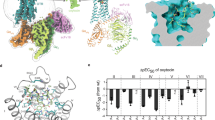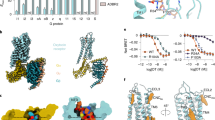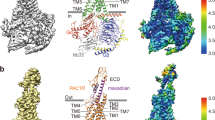Abstract
The first crystal structure of the pituitary hormone oxytocin complexed with its carrier protein neurophysin has been determined and refined to 3.0 Å resolution. The hormone-binding site is located at the end of a 310-helix and involves residues from both domains of each monomer. Hormone residues Tyr 2, which is buried deep in the binding pocket, and Cys 1 have been confirmed as the key residues involved in neurophysin-hormone recognition. We have compared the bound oxytocin observed in the neurophysin–oxytocin complex, the X-ray structures of unbound oxytocin analogues and the NMR-derived structure for bound oxytocin. We find that while our structure is in agreement with the previous crystallographic findings, it differs from the NMR result with regard to how Tyr 2 of the hormone is recognized by neurophysin.
This is a preview of subscription content, access via your institution
Access options
Subscribe to this journal
Receive 12 print issues and online access
$189.00 per year
only $15.75 per issue
Buy this article
- Purchase on Springer Link
- Instant access to full article PDF
Prices may be subject to local taxes which are calculated during checkout
Similar content being viewed by others
References
Insel, T.R. Oxytocin–a neuropeptide for affiliation: evidence from behavioral, receptor autoradiographic, and comparative studies. Psychoneuroendocrinology 17, 3–35 (1992).
Insel, T.R. & Shaprio, L.E. Oxytocin receptor distribution reflects social organization in monogamous and polygamous voles. Proc. Natl. Acad. Sci. USA 89, 5981–5985 (1992).
Moore, F.L., Wood, R.E. & Boyd, S.K. Sex steroids and vasotocin interact in a female amphibian (Taricha granulosa) to elicit female-like egg laying behavior or male-like courtship. Horm. Behav. 26, 156–166 (1992).
Barnshad, M., Novak, M.A. & De Vries, G.J. Sex and Species differencesin the vasopressin innervation of sexually naive and parental praire voles Microtus ochrogaster and meadow voles Microtus pennsylvanicus. J. Neuroendocrinol. 5, 247–255 (1993).
Winslow, J.T. et al. A role of central vasopressin in pair bonding in monogameous prairie voles. Nature 365, 545–548 (1993).
Wang, Z., Ferris, C.F. & De Vries, G.J. The role of septal vasopressin innervation in parental behavoir in prarie voles (Microtus ochrogaster). Proc. Natl. Acad. Sci. USA 91, 400–404 (1994).
Dreifuss, J.J. A review of neurosecreatory granules: their contents and mechanism of release. Annu. New York Acad. Sci. 248, 184–201 (1975).
Land, H. et al. Deduced amino acid sequence from the bovine oxytodn-neurophysin I precursor cDNA. Nature 302, 342–344 (1983).
Land, H. et al. Nucleotide sequence of cloned cDNA encoding bovine arginine vasopressin-neurophysin II precursor. Nature 295, 299–303 (1982).
Ivell, R. & Richter, D. Structure and comparison of the oxytocin and vasopressin genes from rat. Proc. Natl. Acad. Sci. USA 81, 2006–2010 (1984).
Chauvet, M.T. et al. A multigene family for the vasopressin-like hormones? Identification of mesotocin, lysipressin and phenypressin in Australian macropods. Biochem. Biophys. Res. Commun. 116, 258–263 (1983).
Breslow, E. & Walter, R. Binding properties of bovine neurophysins I and II: an equilibrium dialysis study. Molecular Pharmacology 8, 5–81 (1972).
Breslow, E. Chemistry and biology of the neurophysins. Annu. Rev. Biochem. 48, 251–274 (1978).
Menendez-Botet, C. & Breslow, E. Chemical and physical properties of the disulfides of bovine neurophysin-II. Biochemistry 14, 3825–3835 (1975).
Chaiken, I.M., Randolph, R.E. & Taylor, H.C. Conformational effects associated with the interaction of polypeptide ligands with neurophysins. Annu. New York Acad. Sci. 248, 442–450 (1975).
Kanmera, T. and Chaiken, I.M. Molecular properties of the oxytocin/bovine neurophysin biosynthetic precursor. Studies using a semisynthetic precursor. J. Biol. Chem. 260, 8474–8482 (1985).
Ando, S., McPhie, P. & Chaiken, I.M. Sequence redesign and the assembly mechanism of the oxytocin/bovine neurophysin I biosynthetic precursor. J. Biol. Chem. 262, 12962–12969 (1987).
Huang, H.B. & Breslow, E. Identification of the unstable neurophysin disulfide and localization to the hormone-binding site. Relationship to folding-unfolding pathways. J. Biol. Chem. 267, 6750–6756 (1992).
Rholam, M., Nicolas, P. & Cohen, P. Binding of neurohypophyseal peptides to neurophysin dimer promotes formation of compact and spherical complexes. Biochemistry 21, 4968–4973 (1982).
Breslow, E. & Burman, S. Molecular, thermodynamic, and biological aspects of recognition and function in neurophysin-hormone systems: a model system for the analysis of protein-peptide interactions. Adv. Enzymol. 63, 1–67 (1990).
Chen, L.Q. et al. Crystal structure of a bovine neurophysin II dipeptide complex at 2.8 Å determined from the single-wavelength anomalous scattering signal of an incorporated iodine atom. Proc. Natl. Acad. Sci. USA 88, 240–4204 (1991).
Husain, J. et al. The conformation of deamino oxytocin: X-ray analysis of the ‘dry’ and ‘wet’ forms. Phil. Trans. R. Soc. London B327, 625–654 (1990).
Woods, S.P. et al. Crystal structure analysis of deamino-oxytocin: Conformational flexability and receptor binding. Science 232, 633–636 (1986).
Lippens, G. et al. Transfer Nuclear Overhauser Effect study of the conformation of oxytocin bound to bovine neurophysin I. Biochemistry 32, 9423–9434 (1993).
Capra, J.D. et al. Evolution of neurophysin proteins: The partial sequence of bovine neurophysin-I. Proc. natl. Acad. Sci. USA 69, 431–434 (1972).
Burman, S. et al. Complete assignment of neurophysin disulfides indicates pairing in two separate domains. Proc. Natl. Acad. Sci. USA 86, 429–33 (1989).
Breslow, E. The cupric ion complexes of oxytocin and 2-phenylalanine oxytocin. Biochim. Biophys. Acta 53, 606–609 (1961).
Camier, M. et al. Hormonal interactions at the molecular level; a study of oxytocin and vasopressin binding to bovine neurophysins. Eur. J. Biochem. 32, 207–214 (1973).
Blumenstein, M. & Hruby, V.J. Interactions of oxytocin with bovine neurophysins I and II. Use of 13C nuclear magnetic resonance and hormones specifically enriched with 13C in the Glycinamide-9 and half-cystine-1 positions. Biochemistry 16, 5169–5177 (1977).
Stouffer, J.E., Hope, D.B. & du Vigneaud, V. in Perspectives in Biology (eds Cori, C.F. et al.) 75–80 (Elsevier, Amsterdam; 1963).
Ferrier, B.M., Jarvis, D. & du Vigneaud, V. Deamino oxytocin: its isolation by partition chromatography, Sephadexand crystallization from water and its biological activity. J. Biol. Chem. 240, 4264–4266 (1965).
Hallenga, K. et al. in Proceedings 10th American Peptide Symposium, May 1987. (ed. G.R. Marshall) 39–45 (1988).
Live, D.H., Cowburn, D. & Breslow, E. Binding of oxytocin and 8-arginine-vasopressin to neurophysin studied by 15N NMR using magnetization transfer and indirect detection via protons. Biochemistry 26, 6415–6422 (1987).
Balaram, P., Bothner-By, A.A. & Dadok, J. Negative Nuclear Overhouser Effects as probes of macromolecular structure. J. Am. Chem. Soc. 94, 4015–4017 (1972).
Balaram, P., Bothner-By, A.A. and Dadok, J. Localization of tyrosine at the binding site of neurophysin-II by negative Nuclear Overhauser Effects. J. Am. Chem. Soc. 94, 4017–4018 (1972).
Nicolas, P. et al. Bovine neurophysin dimerization and neurohypophyseal hormone binding. Biochemistry 19, 3565–3573 (1980).
Sur, S.S. et al. Fluorescence studies of native and modified neurophysins. Effects of peptides and pH. Biochemistry 18, 1026–1036 (1979).
Rose, J.P. et al. Crystallographic analysis of the neurophysin-oxytocin complex. A preliminary report. J. Mol. Biol. 221, 43–45 (1991).
Howard, A.J. et al. The use of an imaging proportional counter in macromolecular crystallography. J. Appl. Crystallogr. 20, 383–387 (1987).
Fitzgerald, P.M.D. MERLOT, an integrate package of computer programs for the determination of crystal structure by molecular replacement. J. Appl. Crystallogr. 21, 273–278 (1988).
Sussman, J.L. Constrained-restrained least-square (CORELS) refinement of proteins and nucleic acids. Methods Enzymol. 115, 271–303 (1985).
Jones, T.A. & Thirup, S. Using known substructures in protein model building and crystallography. EMBO J. 5, 819–822 (1986).
Brunger, A.T., Kuriyan, J. & Karplus, M. Crystallographic R factor refinement by molecular dynamics. Science 235, 458–460 (1987).
Ramakrishnan, C. & Ramachandran, G.N. Stereochemical criteria for polypeptide and protein chain conformation. Biophys. J. 5, 909–933 (1965).
Bernstein, F.C. et al. The protein data bank: a computer-based archive-file for macromolecular structures. J. Mol. Biol. 112, 535–542 (1977).
Kraulis, P., MOLSCRIPT: a program to produce both detailed and schematic plots of protein structures. J. Appl. Crystallogr. 24, 946–950 (1991).
Ferrin, T.E. et al. The MIDAS display system. J. Mol. Graphics 6, 13–27 (1988).
Author information
Authors and Affiliations
Rights and permissions
About this article
Cite this article
Rose, J., Wu, CK., Hsiao, CD. et al. Crystal structure of the neurophysin—oxytocin complex. Nat Struct Mol Biol 3, 163–169 (1996). https://doi.org/10.1038/nsb0296-163
Received:
Accepted:
Issue Date:
DOI: https://doi.org/10.1038/nsb0296-163
This article is cited by
-
Selenoether oxytocin analogues have analgesic properties in a mouse model of chronic abdominal pain
Nature Communications (2014)
-
Conformation and dynamics of 8-Arg-vasopressin in solution
Journal of Molecular Modeling (2014)
-
A novel variation in the AVP gene resulting in familial neurohypophyseal diabetes insipidus in a large Italian kindred
Pituitary (2013)
-
EGFP-Tagged Vasopressin Precursor Protein Sorting Into Large Dense Core Vesicles and Secretion From PC12 Cells
Cellular and Molecular Neurobiology (2005)
-
Six novel mutations in the arginine vasopressin gene in 15 kindreds with autosomal dominant familial neurohypophyseal diabetes insipidus give further insight into the pathogenesis
European Journal of Human Genetics (2004)



